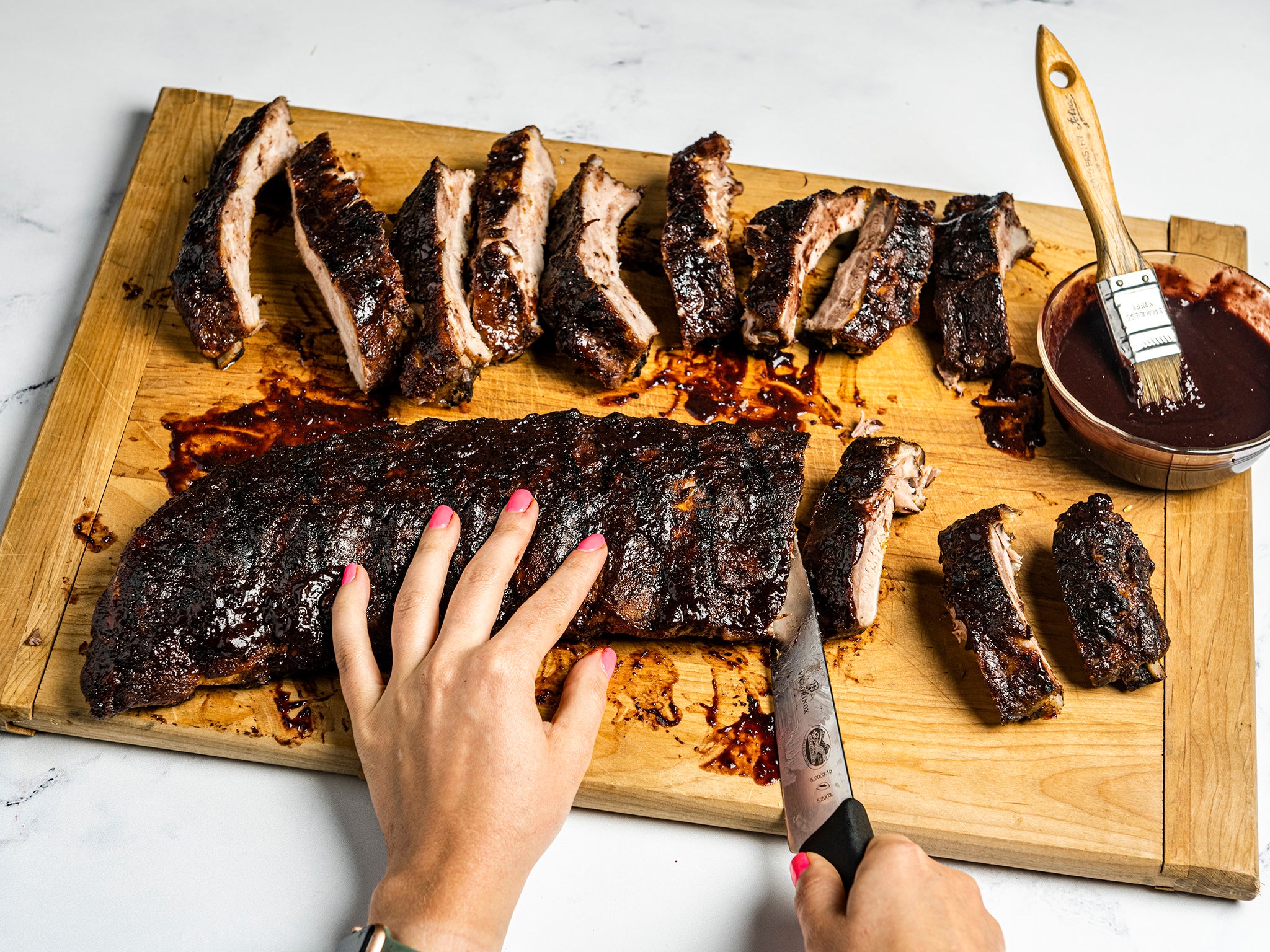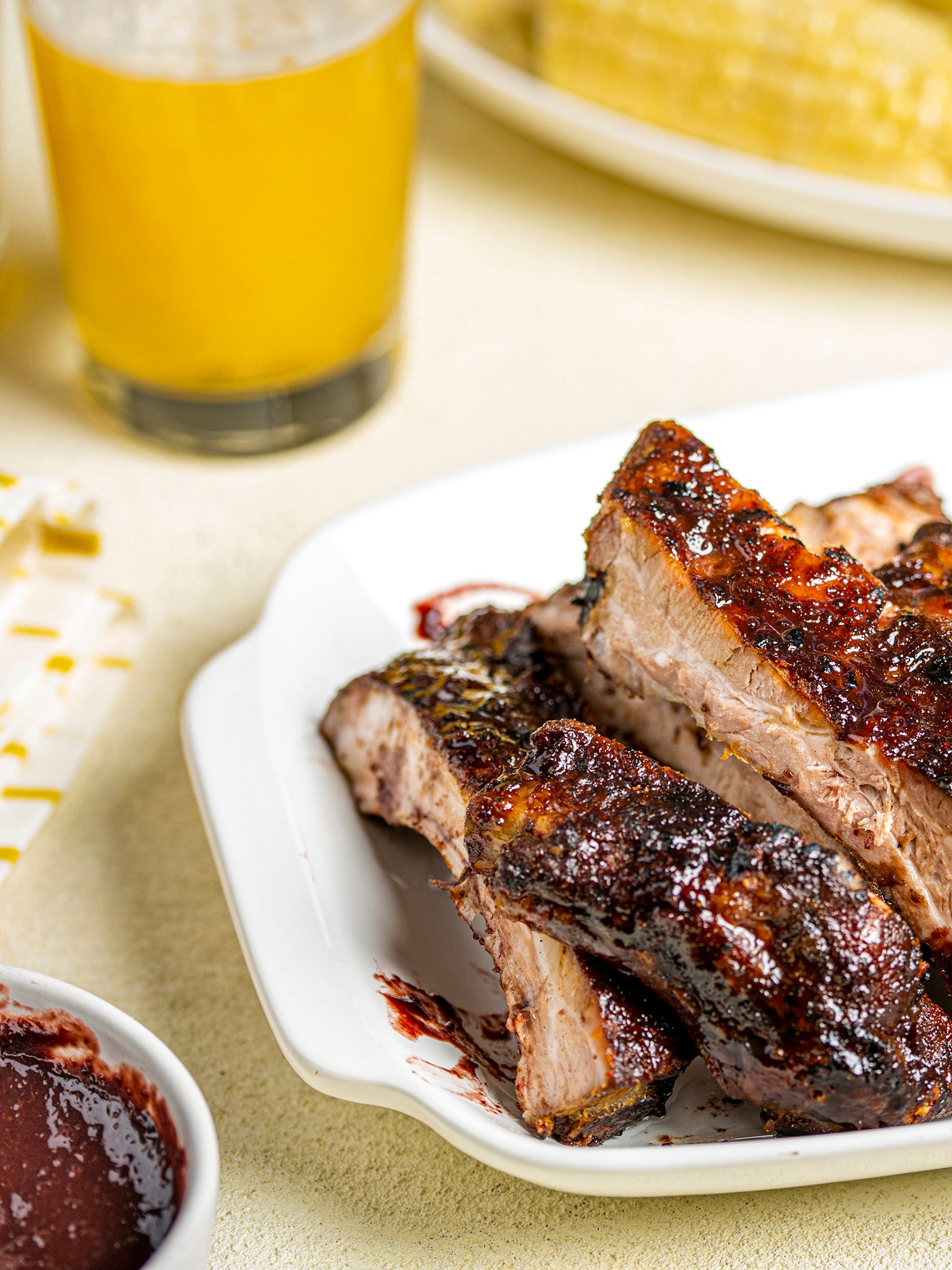How to perfectly cook barbecue baby back ribs
These baby back ribs with a cherry-bourbon glaze are a welcome mess, but easy to cook, says Allison Robicelli

Though it’s true that there really is never a bad time for ribs, summertime barbecued ribs are extra special. You get to eat outdoors. You get to embrace the mess.
Eating ribs indoors requires some modicum of civility so that your clothes, furniture and face remain sauce-free. We nibble at them with sticky pinkies up. We may fantasise about ripping those tender, succulent racks of ribs apart with our bare hands and going to town on them like a dog with a throw pillow, but we don’t, because we are not barbarians.
As winter fades into spring and our days grow longer, our patience for rib restraint grows shorter. We emerge into the great outdoors with a thirst for freedom. Freedom to run through wet grass with bare feet. Freedom to cartwheel on the sand and splash in the surf. Freedom to eat ribs like no one is watching.
The tenderest and meatiest of all ribs are the baby back, which have nothing to do with babies, but everything to do with backs. They come from the back of the pig, where they curve around the loin.
Because this is the leanest part of the pig, baby back ribs have very little fat, and plenty of meat to douse with copious amounts of sweet, sticky sauce. All pork ribs will melt off the bone when cooked low and slow, but thanks to their diminutive size – this is the shortest cut of rib – baby backs will get from the grill to the table faster than all other cuts. This is an important thing to consider when you’re spectacularly ravenous for ribs.
Where the baby backs end, the spareribs begin, curving around the pig’s fatty, flavourful belly all the way to its breastbone. Spareribs are fattier, with very little meat on the top of their long, flat bones, and plenty of well-marbled meat in-between them. More marbling means more flavour, but it also means you need to wait a little longer for your ribs to be fall-apart tender.
On the end of the spareribs where they meet the breastbone is a fatty flap of pork belly-like meat studded with small bits of cartilage known as the rib tip, and it is immaculate when given enough time to melt into the stuff that dreams are made of. If you’d like to use spareribs instead of baby backs in this recipe, give them an extra 10 minutes of low and slow heat, for fall-off-the-bone tenderness make it 20. Then, move them to the direct heat side of the grill, slap on the cherry bourbon sauce, and get ready to have a good time.
St Louis-style ribs are spareribs with their rib tips removed, so you can use them interchangeably with baby backs in this recipe with no adjustments needed. These rectangular racks are an excellent choice if you want the almost-primal experience of feasting on flavourful, fatty rib meat without the gristle.
And, remember, it’s OK to ravage any of these ribs as if we are, in fact, barbarians. After all, it’s summertime.
Cherry-bourbon glazed ribs

Active time: 40 minutes | Total time: 2 hours, 40 minutes, plus overnight refrigeration
Serves: 4
This recipe calls for baby back ribs but can also be made with spareribs or St Louis ribs. Those rib cuts, which come from the belly region of the pig, are flatter, fattier, and more flavourful, but because of their marbling, they take slightly longer to cook; add at least 10 more minutes to the “low and slow” cook time, then use visual cues to determine when they’re tender enough to move to direct heat. This recipe will also produce more glaze than you’ll probably need for two racks of ribs; you can serve it on the side or use it for glazing poultry next time you grill.
Make ahead: The ribs must be rubbed and refrigerated for at least 12 hours or up to 2 days before grilling.
Storage notes: Refrigerate ribs for up to 3 days. Leftover glaze can be refrigerated for up to 1 week or frozen for up to 1 year.
Notes: To prepare your gas grill for indirect-heat grilling: cover and preheat with all burners on high until it reaches 150C. When ready to cook, if using a three-burner BBQ, turn the middle burner off and reduce the heat on the other burners to medium-high. Many two-burner BBQs are set up for indirect heat, so you can simply place the food in the centre of the cooking grate. Heat one burner to medium-high and leave the other one off.
If using a charcoal BBQ: fill a chimney starter with charcoal, light it, and when the coals are ashed over, arrange them on either side of the pan, leaving an empty spot in the middle. If your grill is too small to allow for an empty spot, push the coals to one side, leaving the other side empty. Pour enough water into the pan to come at least 2½cm up the side. Replace the cooking grate, and set an oven or grill thermometer on top. Cover the grill and preheat to medium-low, about 150C. For a medium-low fire, you should be able to hold your hand about 15cm above the coals for about 8 seconds.
If using a charcoal BBQ, the recipe may take about 15 minutes longer.
Oven method: these ribs can be slow-roasted for 1½ to 2 hours in a preheated 150C oven as well. To caramelise the glaze, at the end, raise the rack to about 15cm from the grill and grill for about 3 minutes, watching carefully so the glaze does not burn.
Ingredients:
For the ribs:
2 racks (1.4kg total) baby back ribs
2 tbsp Dijon mustard
50g packed light brown sugar
2 tsp ground cumin
2 tsp smoked paprika, mild or hot
1 tsp garlic powder
1 tsp onion powder
1 tsp fine salt
2 tsp ground black pepper
For the glaze:
One (450g) bag frozen cherries
120ml bourbon
60ml pomegranate molasses
Finely grated zest of 1 orange
½ tsp ground cloves
½ tsp fine salt
½ tsp ground black pepper
Method:
Remove the silver membrane off the back of the baby back ribs by sliding a butter knife under the skin in the mid-section, and lifting and loosening until you can grab a portion with a towel, so you can tear off first one side, then the other.
Dry the ribs well and brush each with 1 tablespoon of the mustard.
Cure the ribs: in a small bowl, combine the sugar, cumin, paprika, garlic and onion powder, salt and pepper. Cover the ribs on both sides with the dry rub. Place in an airtight container or wrap in plastic wrap and refrigerate for at least 12 hours and or up to 2 days.
Grill the ribs: remove the ribs from the fridge and let come to room temperature for about 1 hour before grilling.
Prepare the BBQ for indirect heat (see notes above). Place a heatproof or aluminum pan next to the coals on the cooler side of the grill. Pour enough water into the pan to come at least 2½cm up the side. Place the grate over the pan and coals and place the ribs over the pan bone side down. Close the BBQ, and adjust the heat to maintain a temperature of about 150C. Cook for 2 to 2½ hours, or until the meat begins to fall off the bone.
Make the glaze: while the ribs are grilling, in a 1.9L saucepan over medium heat, combine the cherries, bourbon, molasses, orange zest, cloves, salt and pepper. Bring to a simmer, stirring frequently, and cook until the cherries begin to soften, 13 to 15 minutes. Remove from the heat and, using an immersion blender, puree the glaze until smooth (alternatively, you can spoon the mixture into a blender or food processor and puree until smooth). Return the pan to medium-low heat, and continue cooking, uncovered, until thick, about 5 minutes. Remove from the heat and set aside; you should get about 2 cups of glaze (you’ll need about 1 cup for glazing).
Have a cutting board and serving platter handy.
Brush the ribs with the glaze and slide them to the direct heat side of the grill. Cook, uncovered, for about 5 minutes, then brush the ribs with more glaze and turn them so they are meat side down (if you have any flare ups, move the ribs slightly to the side so they’re not directly over an open flame). Continue grilling, uncovered, until the sauce begins to caramelise, 5 to 10 minutes.
Using tongs, transfer the ribs to a cutting board and use a sharp knife to cut between the bones. Place the ribs on a serving platter, brush with more glaze and let rest for at least 10 minutes before serving.
Nutrition information per serving (4 ribs, ¼ cup glaze) | Calories: 825; total fat: 40g; saturated fat: 8g; cholesterol: 252mg; sodium: 1134mg; carbohydrates: 27g; dietary fiber: 2g; sugar: 26g; protein: 67g.
This analysis is an estimate based on available ingredients and this preparation. It should not substitute for a dietitian’s or nutritionist’s advice.
© The Washington Post

Join our commenting forum
Join thought-provoking conversations, follow other Independent readers and see their replies
Comments